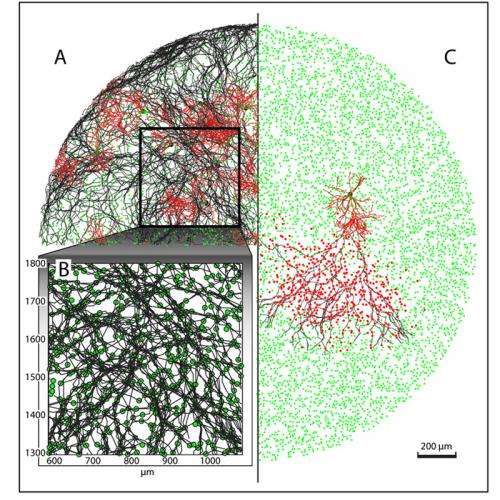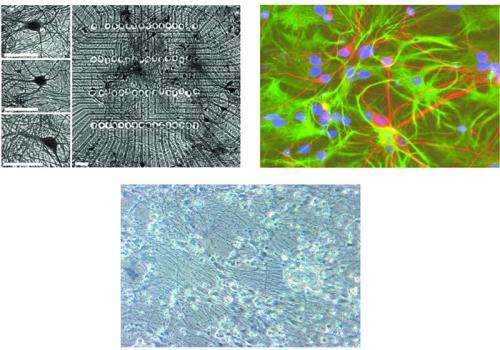Young brain develops activity peaks while it is still growing

After a short period of growth, cultured networks of neurons regularly exhibit major activity in the absence of external stimulation. These "bursts" are entirely related to growth. At this stage, they have little to do with learning behaviour, as the network is still too young to sustain a process of memory formation. This has now for the first time been simulated for networks ranging in size from 10,000 to 50,000 neurons. The simulations provide insight into the role of the growth process in initial activity. Researchers at the University of Twente's MIRA Institute recently published details of this work in PLOS ONE.
"Isolated" neurons, which have yet to form any interconnections, soon put out cell extensions (axons and dendrites) that connect them to other neurons. The resultant network starts to show signs of activity after just one week. The researchers made these observations in networks that they had cultured from neurons extracted from the brains of young rats. These cells were grown in culture dishes whose bases had been fitted with electrodes. Here, the network grows in a single plane, as far as possible. If it were to grow "upwards" (3D), it would be difficult to determine what was actually being measured. After a week, observations show that the neurons have become active and that they start to "fire". This activity can be seen to pass through the entire network in the form of a "burst".

The question was whether these bursts might be related to the development of a long-term memory, by a process of synapse strengthening. This process of memory formation begins to develop after three weeks. Now, for the first time, substantial computer capacity has been used to simulate larger networks (10,000-50,000 neurons). This showed that the bursts really do arise during the first few weeks of growth. The simulations reveal a correlation between the growth of the network and the occurrence of the first bursts, which is in line with the observations. The burst runs through the network like a wave, at enormous speed. As in the experiments, no external stimulation was applied to the network. However, the simulations do include certain types of neurons that act as "pacemakers" by initiating a process. This corresponds to what happens in reality.
A realistic simulation model that simultaneously calculates both growth and activity provides a better picture of the workings of a "brain" of limited size. Bursts are the expression of coordinated action in networks. They are generally seen as building blocks of human brain function. If coordination between networks is disrupted, bursts can degenerate into total discharges of the type seen in brain abnormalities such as strokes or epileptic seizures. One particularly exciting research question being explored by Prof. Wim Rutten's group is whether artificially cultured brains could be linked to robots, for example, as they learn more efficiently than any existing algorithms. The use of reliable simulations will also help to reduce the number of experiments involving living neural networks.
More information: The article entitled "Growth dynamics explain the development of spatiotemporal burst activity of young cultured neuronal networks in detail" by Taras Gritsun, Joost le Feber and Wim Rutten, has been published in PLOS ONE, Volume 7, Issue 9.
















